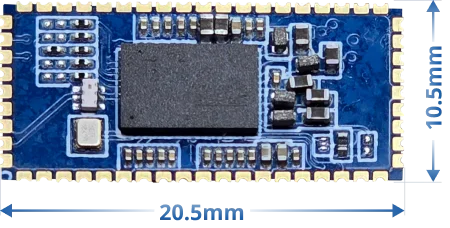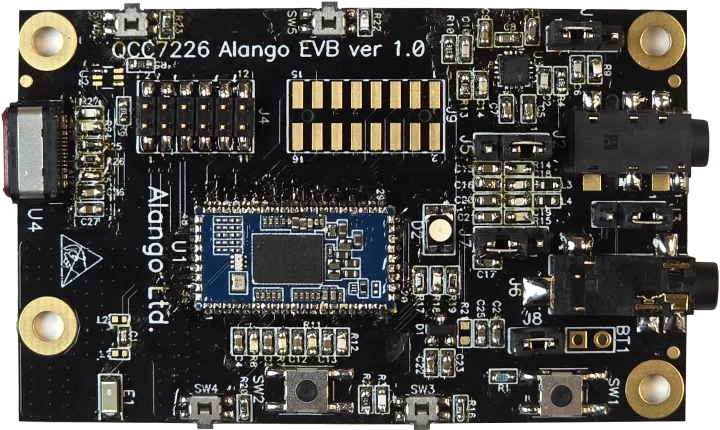| c |
|
 |
|
The Alango Sound Processing Module (ASPM) bypasses design complexities by offering a ready-made solution with qualified hardware and pre-integrated software. This modular solution accelerates development and streamlines testing, allowing design hours to be focused on critical aspects of the product itself rather than low-level tasks. Optimal performance, simplified design, and fast time to market are hallmarks of the ASPM, which provides all sound processing technologies offered by Alango for voice, hearing, and audio.
The ASPM will facilitate the creation of all kinds of sound processing devices. The ASPM comes in two variants depending on the application: 1. COMMUNICATION SYSTEMS ASPM:
2. CONSUMER, SMART HOME ASPM:
ASPM is a hardware DSP module in two iterations, either the QCC7226 or QCC5229 SoC ICs, which includes a main DSP for audio use cases with low power consumption. The multicore compute architecture with dedicated low latency audio and AI accelerators includes dual-mode Bluetooth® and integrated QSPI flash memory. Alango’s Sound Processing Module (ASPM) serves two flexible roles in audio device development. It can be embedded directly as a pre-built sound processing solution in mass-market devices, allowing manufacturers to add advanced audio features without the need for custom sound engineering. Alternatively, ASPM can function as a cost-effective development platform/tool tailored for Qualcomm S7/S5 applications, offering developers a ready-to-use hardware and software environment to create and test audio processing features. This versatility supports both rapid product deployment and in-depth prototyping for custom sound solutions. The Alango Sound Processing Module (ASPM) supports Bluetooth Low Energy (BLE), BLE Audio, and Auracast™, offering robust connectivity options for modern audio applications. BLE provides efficient power consumption and is ideal for device-to-device communication, especially for wearable and portable devices. BLE Audio builds on this by enabling high-quality, low-latency audio streaming, making it ideal for voice, music, and gaming applications. With Auracast™, ASPM adds the ability to broadcast audio to an unlimited number of nearby receivers, which is useful for public and shared spaces where multiple users can access the same audio stream simultaneously. This comprehensive support makes ASPM well-suited for next-generation audio devices focused on seamless, high-quality user experiences. A list of the main technologies that can run on the ASPM is as follows: |
| Adaptive Dual Microphone and Multi-Microphone Array |
Uses multiple microphones to focus on a sound source and reduce background noise. Analyzes microphone signals to determine direction and improve sound quality. |
|||
| Noise Suppression |
Processes audio signals by dividing them into frequency sub-bands and estimating noise levels. It then attenuates noise while preserving speech quality, effectively suppressing both stationary and transient noises. |
|||
| Echo Cancellation |
Employs an adaptive filtering algorithm that adjusts itself to minimize echoes, even during double talk. Additionally, it includes a feature that automatically monitors the echo cancellation's effectiveness and suppresses any remaining echoes that are not obscured by the desired sound. |
|||
| Acoustic Feedback Reduction |
Employs sub-band adaptive filters to estimate and reduce echoes between the speaker and microphone to prevent feedback oscillations. |
|||
| Adaptive Wind Noise Reduction
|
Sub-band processing technology ensures that only the problematic frequency bands containing wind noise are suppressed, preserving the quality of the original signal. |
|||
| Automatic Gain and Volume Control |
Automatically adjusts the signal gain to ensure optimal voice levels, regardless of the ambient noise. It increases gain for weak voices and reduces it for strong ones, preventing noise amplification during speech pauses. |
|||
| Multichannel Dynamic Range Compression |
Modifies the dynamic range of audio signals by compressing or expanding the difference between the loudest and quietest sounds, allowing for a more balanced and consistent listening experience ensuring that both loud and soft sounds are audible and comfortable. |
|||
| Intelligent Speech Mixer |
Combines multiple signals from microphones of a multi-point/multi-zone voice communication system into a single enhanced signal. It does this intelligently to preserve the signal to noise ratio. |
|||
| Music Enhancement
|
Improves perceptual audio quality by dynamically adjusting the stereo image, frequency response, and bass levels to compensate for the limitations a given device. This results in a natural and undistorted sound experience. |
|||
| Speech Recognition Enhancement | Improves speech recognition performance in voice-controlled multimedia devices. It is a front-end solution that performs audio signal pre-processing prior to the Automatic Speech Recognition (ASR) and Key Word Recognition (KWR) engines. | |||
|
AUDIO INTERFACES
HIGH-PERFORMANCE COMPUTE CENTER FOR AUDIO APPLICATIONS
BLUETOOTH® 5.4
The ASPM EVB allows designers to tune, evaluate and test all functionalities of the module. The ASPM EVB is easy to use and includes all the basic necessary hardware, making it a perfect tool for rapid evaluation and prototyping while shortening time to market. The EVB and accompanying kit enables real time monitoring of the digital input and output audio streams within the DSP and allows setting VCP parameters on the fly for tuning VCP processing. Hence, all necessary hardware and software is included to modify and optimize the embedded DSP software for the target acoustic system to achieve the best voice quality. TECHNICAL INFORMATION
|

